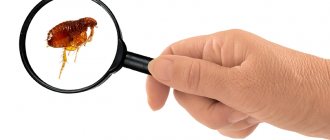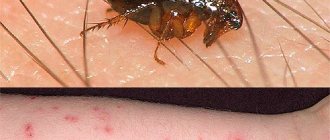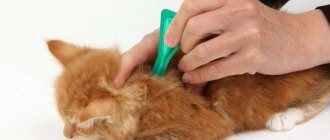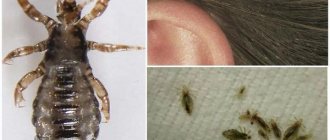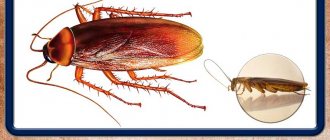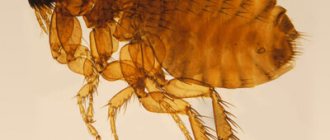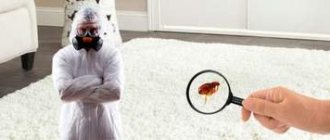Fleas are parasitic insects that every pet owner has to fight. Moreover, some people think that blood-sucking insects are the prerogative of only animal owners. However, this opinion is erroneous: recently, bloodsuckers have begun to appear in multi-storey buildings, causing great discomfort to their inhabitants with their bites. The importance of the problem can be assessed if you know how long fleas live without an animal in the apartment.
How long do fleas live?
In favorable conditions for life, fleas live up to three months, during which the female lays approximately 500 eggs.
The most comfortable conditions for parasites are a temperature of 21-26 degrees above zero, and a humidity of about 80%. When the temperature increases by 10 degrees, the development of fleas almost doubles. A decrease in temperature, on the contrary, leads to a slowdown in the growth of insects and an increase in life expectancy up to 2 years. The reproduction cycle of insects also depends on the temperature regime. At optimal temperatures, the development period of the larvae is one month, at elevated temperatures - up to 10 days, at very low temperatures - up to 7 months. Then the eggs develop within 14 days; the insect remains at the pupal stage for about 20 days. In general, the full development cycle lasts from 10 days to one year, and life expectancy - from 1.5 months to several years.
Climatic conditions
All insects are afraid of low temperatures, including fleas. If the thermometer drops below 0⁰C, then the young animals will die in 3-5 days . The pest will survive up to +5⁰C for at most 10 days. The minimum temperature level when a flea can more or less exist is +10⁰C. The chance of survival in this case is 50/50.
Young animals are more vulnerable to low temperatures than adults. Larvae with laid eggs stop developing already at +13⁰С. At +10⁰С all offspring die.
Like other insects, a flea can hibernate, but provided that the temperature does not drop below +8⁰C. Heat also negatively affects the life of parasites. If the thermometer rises above +35 degrees, the pest will die in a matter of days. Dryness can also be considered a critical factor. Low air humidity has an extremely negative effect on both the offspring of the insect and the adults. The larvae begin to die inside the cocoons. In the summer months, when the heat stays at 30⁰C, the flea population decreases.
Read more ► Linen fleas, what do they look like, why are they dangerous and how to get rid of them?
How long do fleas live without food?
Fleas can go without food for about 2-3 months; their bodies are adapted to living in unfavorable conditions and the absence of a food source. But fleas cannot go on without food indefinitely, because they need fresh blood to reproduce and lay eggs.
When leaving the apartment with your pet for a long time, you should not expect that the fleas will die without the animal; they will definitely wait for the cat or dog to arrive and bite them. A peculiarity of country fleas and other types of fleas is their ability to sometimes feed on the blood of rats and mice, so they can wait for a long time for the owner with their pet.
Parasites in the house
In general, of all fleas, the largest species live the longest, parasitizing mainly on ungulates.
The so-called “variegated worm” - the Tien Shan flea, reaching a length of 7 mm - lives on sheep for about a year. Some fleas that parasitize northern animals can fall into prolonged torpor during the winter period and generally live for more than 14-16 months. At low temperatures for these species, their lifespan can be several years.
In addition to the fact that insects are desperately hunted - they are poisoned by people, bitten by animals - they can also die from their own infectious and parasitic diseases. Sometimes it even happens that a flea is left without food, for example, if it lives in the litter and the animal is taken to the country.
How long can a flea live without food? Quite a long time: her body is adapted to survive such unfavorable conditions. Insects that live on pets and can bite humans can survive in a cool apartment for several months even in the absence of food. The parasites remain active and do not fall into a “half-asleep” state, but cannot lay eggs. The reproduction process requires replenishment in the form of regularly supplied blood from the host, so there will be no offspring from a starving female.
How long fleas live in an apartment without owners will depend on the air temperature. The lower it is, the greater the insect’s chance of waiting for the arrival of a food source. So, having gone to the country after treating an animal with a special preparation and returning a month later, after some time you can note the return of the problem.
Parasites enter the apartment along with pets or the owners themselves. For example, while walking, a dog comes into contact with other dogs and becomes infected from them. Returning home, she brings the parasites with her.
Getting rid of parasites in an apartment is not an easy process, requiring a long time and considerable effort. Firstly, it is imperative to find the reason for the appearance, since otherwise the situation may repeat itself. Fleas multiply quite quickly, so once you eliminate the outbreak, you can start cleaning the entire room.
So, you have identified the source of occurrence, now you can start cleaning the apartment. Housing is treated with insecticidal preparations. As a rule, spraying action. This form of drug release is more suitable, since it is necessary to cover a large room. Therefore, the spray is the most effective remedy. But there are other means.
We suggest you read: How much mustard should you put in your child’s socks?
To summarize, we can say that there are a large number of insect control products. They have different directions and methods of influence.
How long do flea larvae live?
The larva, depending on conditions, lives 5-45 days. Humidity and ambient temperature indicators are very important for it. It is very important that she has access to food - the excrement of adults, imagoes.
If you have a flea infestation, there will be a lot of eggs and droppings on the carpets, pet bedding, upholstered furniture, and other areas.
In apartment conditions, the larva develops into a pupa in 7-12 days. If the room is cool, dry, and there is little nutrition, the development process is slowed down for up to a month and a half.
Then the pupal stage begins. It develops in a cocoon for 7-19 days. Females develop 20% faster. If the temperature drops, the development of the pupa slows down.
The development process is affected by humidity, temperature, and nutrition. The better the larva ate, the longer the pupa develops. In order for her to leave the cocoon, the level of nutrients and fluid in her body must become critical. In some cases, being in a cocoon can take up to 5 months.
The flea leaves the cocoon when it senses the presence of its owner. She learns about it by temperature and pressure. These signals become a call to exit.
Life cycle of a flea
On average, fleas Pulex irritans, Ctenocephalides felis, Ctenocephalides canis, Xenopsylla cheopis or other types of similar bloodsuckers live 1-1.5 years. Moreover, they remain in the pupal stage for a very long time - under not the most favorable temperature conditions, bloodsuckers remain in this state for several months.
Even when this small pest becomes an adult and enters the adult stage, it continues to live in its small cocoon and waits for a specific moment for further hatching.
The life span of a flea directly depends on their type and size of the flea, food and living conditions in the natural or other environment. Most often, such bloodsuckers live for about 6 months. During this time, this small pest bites its “carrier” more than 200 times.
The life cycle of a human or other flea consists of 4 stages of development:
- the birth of a bloodsucker in an egg;
- the appearance of flea larvae;
- transformation of an insect into a pupa;
- hatching from the pupa into an adult flea - “imago”.
These small pests, like certain other parasites, also go through the 2nd above-mentioned stage of development of a cat or other flea - the appearance of a larva.
What do the larvae of these bloodsuckers look like? The flea larva has sharp small jaws that gnaw the egg from the inside.
Larvae of small pests Pulex irritans die due to the following factors:
- low or high air temperature - about -50 or above +40 degrees Celsius, respectively;
- constant exposure to water;
- daily exposure to direct sunlight.
What determines the lifespan of fleas?
The duration of a flea's existence is influenced by a number of factors:
- Ambient temperature and humidity. At low humidity and temperature, bloodsuckers will live longer than at high temperature.
- Constancy of the state of the environment. If the temperature fluctuates frequently, the parasites fall into a state of torpor. Thanks to him, bloodsuckers live longer.
- Food. If a flea goes hungry, it will live even longer.
A flea is primarily a parasite. Nature provides that their reproduction depends not so much on timing and speed, but on the number of offspring each female produces. You should not hope that in your home such an important process of reproduction will somehow stop on its own.
It is important to poison these parasites completely. It is necessary to destroy both adults and larvae and egg laying. Only after this can we hope that the parasites will disappear completely.
How long do fleas live in extreme conditions?
The life cycle of a flea is maximally tuned to survival. Some individuals can even survive the animals on which they settled. They are able to withstand environmental challenges, both heat and cold.
If the host animal dies, the fleas immediately leave it. The blood of a dead animal does not suit them.
It is curious that the flea pupa is most adapted to extreme conditions. It can withstand icing, frost, severe drought and even the destructive effects of insecticides. The viability of the pupa, even in unfavorable conditions, can persist for several years.
What diseases do fleas carry?
All types of fleas can be carriers of infectious diseases.
The most common infections include:
- plague;
- yersinosis;
- pseudotuberculosis;
- typhus;
- salmonellosis;
- tularemia.
Pathogens enter the human bloodstream through saliva when bitten. The rat flea is the most common carrier of infection, as it parasitizes rats, which spread diseases.
Can they live in an apartment without animals?
To fully answer the question of whether fleas can live in an apartment without animals, it is necessary to consider the features of the insects’ life cycle. The optimal conditions for their full development are the following: constant temperature maintenance within 21 - 23 degrees, humidity - about 80%.
If the above conditions are maintained, the life expectancy of fleas is from two to three months.
A particularly important factor for adult parasites and their larvae is the presence of a constant source of food. The absence leads to a slowdown in the development of the nymph and the absence of the ability to reproduce in the adult. In the absence of food, the life expectancy of the parasite increases.
A similar thing happens when the ambient temperature drops. At higher values, the development of the nymph occurs faster, and the life expectancy of an adult insect is reduced, often by more than half. During this time, one female manages to lay from 400 to 600 eggs.
Fleas can live without animals in an apartment for two to three months. Mostly they do not live on the pet’s fur, but, for example, on its bedding. When the need arises, the blood-sucking flea attacks the animal; immediately after saturation, the flea jumps off.
Can fleas live in clothes and in the sofa?
At first glance, it may seem that the “flea army” lives on animal hosts, but this is not so. Parasites need a quieter place to live and reproduce. That's why they live on a pet's bedding, under linoleum, behind baseboards, in carpets, upholstered furniture, plush toys, and in bed. People often ask the question: “Can fleas live in a sofa?” - and receive an affirmative answer: “Yes!” They may also get into clothing or clutter.
Types of fleas
The main types of fleas living in the middle zone:
- Feline.
- Sandy.
- Earthy.
- Homemade.
- Rat.
- Chicken.
- Human.
sand flea
This type of flea lives in sand. They are distinguished from other varieties by their light color. Sand fleas feed on the blood of humans, cats, dogs and other mammals. The main feature of these individuals is the type of feeding of the female: they bite into the surface of the skin, quickly get to the vessel and drink blood.
After a certain time, the eggs ripen in the female, and she significantly increases in size (about the size of a pea). When it is necessary to lay eggs, the female shoots them out of the oviduct, while she remains in the thickness of the skin.
Earth flea
Externally, this type of flea is practically no different from other species. Individuals feed on the blood of mammals. Most often, residents of the first floors, as well as those who have high levels of humidity in the room, suffer from them.
Habitats: basements, baseboards, furniture, soil.
House flea
This flea can be of several species that can live in a warm room. They can be found in animal bedding, on animals, under baseboards, in furniture, carpets, and bedding. As a rule, they feed on the blood of cats and dogs, and in rare cases, human blood.
Human flea
These individuals are dark brown in color and their size does not exceed 4 mm. The length of the jump is up to one and a half meters, the height is up to 30 cm. They prefer to feed on the blood of cats, dogs, pigs and people.
This is due to the lack of hair, which makes it much easier for them to move. This type of flea does not have thoracic teeth, which help them move through the fur.
Dog flea
This species is close to the cat flea. The size of insects does not exceed 5 mm. Dog fleas are carriers of various parasites and infections.
They can parasitize dogs, cats and other mammals. Eggs are laid according to the same principle as cat fleas (on animals), but since they are not fixed, they very quickly end up in the environment.
Rat flea
Fleas of this species range in color from light brown to dark brown. They reach 2 mm in length. Most often they live in basements, so their main diet is the blood of rats and mice.
cat flea
The head of these fleas is flatter than that of other species. The length of the individual is up to 0.5 mm. Cats can become infected with them on the street or from their fellow cats.
It is not always possible to find this parasite on cats. This is due to their active care of their fur.
Chicken flea
Affects domestic and wild birds. Their distinctive feature is the presence of horny forceps in males. Bite areas are areas of the beak and eyes where there are practically no feathers. They can feed on the blood of other animals, as well as humans, but not for long. Chicken fleas do not live in a house where there are no wild or domestic birds, and if they do live, they do not live for long.
Types and size
There are about 2,500 species of fleas in the world that live on animals and birds.
which are more common:
- feline;
- canine;
- human;
- bird;
- rat.
The most common cat flea in the city can also bite people and dogs. is less common, which is associated with an improvement in people’s quality of life.
The size of the parasite depends on the species. The length of the largest flea reaches 13 mm. This species can be found in North America and only in the habitats of the mountain beaver.
https://youtube.com/watch?v=74KwmGIZ7Oo
Flea lifestyle
The flea belongs to the order of blood-sucking arthropods. The insect moves by jumping, which can reach 30 cm in height and 50 cm in length. The body of the parasite is flattened laterally and covered with bristles; this structure allows it to move quickly in the animal’s fur. There is a sensory organ on the abdomen that signals the approach of a potential food source and a change in temperature.
Where live
Most often, fleas can be found on dogs and cats, so it may seem that the animals harbor parasites. In reality, warm-blooded animals and humans serve only as a source of food for fleas.
After feeding on blood, the insect jumps off the cat or dog to find a place to breed. In the apartment, parasites live in animal bedding, long-pile carpeting, and the floor. In nature, fleas choose places close to animal habitats. These could be holes, bird nests, garbage dumps, basements.
Flea life cycle, reproduction and development
Stages of flea development.
The life cycle of an insect consists of the following stages:
- Egg.
- Larva.
- Doll.
- An adult, or imago.
The female, after being saturated with blood, which is necessary to reproduce, mates with the male. After fertilization, she lays 4-10 eggs. The eggs are fired over a long distance - this method of laying allows future larvae not to compete for food sources and increases the likelihood of survival.
2 weeks after laying, larvae emerge from the eggs and eat the feces of adult insects, blood residues, and organic matter. At favorable temperature and humidity, the larva can emerge from the egg in 2 days. Before the formation of the pupa, the larva goes through 3 stages of molting. The time it takes for an adult to emerge from a pupa depends on environmental conditions and ranges from 1-2 weeks to 1 year.
Reproduction rate
With good nutrition, fleas multiply quickly: a female can make 2-3 clutches per day, that is, lay up to 30 eggs per day. But more often she has enough strength to make one clutch of eggs. During her life, the female lays up to 500 eggs, after which she dies.
Methods for eliminating fleas in animals
Pets must be treated first. There are many means for these purposes.
Special shampoos . The product is applied to the pet’s fur while bathing, after 3-5 minutes it is washed off with clean water, then the animal must be thoroughly combed.
Sprays and drops are very effective in controlling fleas. The drops should be applied to the animal's skin along the ridge to prevent the drug from being licked off. The spray is applied to the entire coat by spraying.
Anti-flea collars are used not only to get rid of parasites, but also as a preventive measure. Biological or chemical flea collars for dogs and cats can be purchased at veterinary clinics or pharmacies.
Symptoms indicating a dog infection
In addition to a visual examination of the pet, the presence of “bloodsuckers” is indicated by the following symptoms:
- The dog itches and does it continuously.
- The animal suddenly jumps up and tries to bite itself.
- Red spots of unknown etiology appear on the dog's skin.
- Bald patches, sores and scratches form on the dog's body.
- The animal whines pitifully for some unknown reason.
- The dog begins to shed prematurely.
- The pet becomes restless and irritable, loses appetite, and suffers from insomnia.
- A sharp decrease in the animal’s weight with proper feeding.
As soon as the animal shows the above signs, it must be immediately shown to a veterinarian
to make an accurate diagnosis and prescribe treatment. Delay in this matter is unacceptable.
Folk remedies against fleas in animals
- Treat your pet's fur with a solution containing essential oils of lavender and cedar (2 drops of oil per 500 ml of water). Spraying should be done daily for two weeks.
- Make a compress from a mixture of camphor alcohol, 3% acetic acid and regular cologne. Hold a plastic bag in the area of the cat's neck moistened with this solution. Then comb the coat well over a bowl of water.
- Dissolve regular table salt in warm water and keep the cat in it for about 10-15 minutes.
- Chop a couple of cloves of garlic and add half a glass of water, let it sit overnight, and rub the resulting solution into your pet’s skin.
- Combing the fur using baking soda; after the procedure, the animal must be washed.
- Treating the animal with lemon spray. Cut the lemon into several parts and boil in a liter of water. Leave the resulting liquid for 6-8 hours, strain and pour into a spray bottle.
After removing fleas from pets, it is necessary to carry out a general cleaning of all areas where parasites may live.
Getting rid of fleas
If you use an integrated approach, you can fix the problem quite quickly. You need to act step by step.
Cleaning and tidying up the living space
It is necessary to pay attention to all surfaces and corners, spaces behind furniture. A mop, rags, and especially a powerful vacuum cleaner will help, since flea eggs can be found in cracks in the floor and other places where they cannot be swept out. In addition, you can use a broom to scatter the eggs around the room, rather than collecting them on a scoop. Retaining eggs after harvesting will provoke re-infestation. It would not be superfluous to add essential oil or flea shampoo to the water during wet treatment.
Washing bed linen
The best option is to wash at temperatures above 60 degrees and dry outdoors in the sun. After drying, the linen should be ironed.
Wardrobe check
The spread of insects in clothing cannot be ruled out. It should be treated with an iron or steam generator, and if possible, dry cleaned. When disinsection, clothes should be hidden in bags.
Pet care
Pet hair must be treated with a special preparation, one of which is BARS® drops for dogs and cats. The product provides maximum results with minimal toxicity. Dishes, tray, toys, bedding, etc. should be washed in very hot water.
Room treatment
Today, the choice of products in stores to combat parasites is very large - you can find drugs in the form of aerosols, concentrated solutions, various powders and pencils.
Concentrates have the greatest effect and are low cost. One bottle of this product is enough to treat the entire apartment. However, the drugs are very toxic and have an unpleasant odor; the procedure must be carried out with gloves and glasses, in the absence of children and animals.
The most famous con, “Taran”, “Dobrokhim”, etc.
Aerosols in cylinders can be used to treat office and residential premises. They are not affordable for everyone, but they are very convenient and easy to use, and sometimes have a pleasant aroma.
The treatment should be carried out with the windows and doors closed; it is possible to ventilate the room 2 hours after the procedure.
The following brands are popular: “Raptor”, “Dichlorvos”, “Reid”, etc.
Powders and pencils : mainly used to remove flea larvae in places where they are most concentrated (basements, attics, cellars). They are low cost and have a good effect in getting rid of parasites.
You can purchase the following names: “Phenaxin”, “Tornado”, “Baygon”, etc.
If you are unable to cope with harmful insects on your own, you can use the services of a special service that will professionally help solve the problem quickly and reliably.
The preparations used by the services are highly toxic, so it is better to leave home for 2-3 days during treatment, and upon return, thoroughly wash the floors and wipe all surfaces with special products.
How can you tell if your pet has fleas?
At the first stages, insects are quite difficult to notice, but after a long time, you will notice clear signs of the presence of fleas in your home.
You will be able to immediately notice insects, if your cat becomes allergic to their bites, then all signs of the disease will begin to appear immediately, and every day the pet will get worse if you do not start removing fleas from your pet’s fur.
Unlike bedbugs, fleas do not inject an anesthetic into the body during a bite, so if your animal often suffers from insomnia, then this is a sure sign that there are fleas in your apartment.
In the later stages of an insect infestation, your pet will begin to vigorously scratch the wounds left by flea bites. Soon ulcers begin to appear on the animal’s body, and there is a risk of introducing a dangerous infection into the blood.
In areas where fleas are concentrated, a dog or cat's hair may begin to fall out. To determine if your pet has fleas, sit him on a white piece of paper and comb him thoroughly. If black dots appear on the paper, then this is nothing more than flea feces, and you should no longer have any doubts about the presence of insects in the house.
The photo shows a flea.
Very often, fleas like to settle in places that are not accessible to your normal gaze. Therefore, start examining your pet from the area near the tail and not far from the stomach. Run your hand over the fur, spreading it slightly to notice the insects parasitizing on the animal's skin.
Pest control
The lifespan of a flea, even under favorable conditions, is about 3 months - during this time it will have time to cause a lot of trouble. Therefore, you need to quickly purchase a special spray against blood-sucking pests. Standard packaging is designed to cover an area of about 10 square meters. You can carry out disinfestation yourself or with the help of a service that processes apartments.
- It is necessary to spray the product especially carefully in areas where fleas live. These are cracks in the floor, hard-to-reach places behind furniture, areas behind baseboards, etc. After treatment, leave the room for at least 2 hours.
- The floor should not be washed for at least 5 days. The flea nest, wherever it is, will suffer, but the eggs will be untouched. After a few days, larvae will emerge from them, which will die only after contact with the treated surface. If 3 weeks after disinsection the insects are still jumping, the procedure should be repeated.
Important!
When working with toxic substances, you must wear a respirator and gloves.
How quickly do fleas die when treated with insecticides?
After synchronous treatment of the premises and pets, flea imagoes die within 1-2 days. But the insecticide does not penetrate deep into the carpet, where eggs, larvae and pupae hide. In addition, the cocoon reliably protects the pupa from chemical exposure.
After how many days should I re-treat fleas?
When using long-acting contact preparations, adults emerging from cocoons will die within 3-4 weeks. However, over time, the properties of the chemical weaken. It is recommended to re-treat the premises after 2-3 weeks. As a rule, two or three treatments are enough to remove a colony of domestic fleas.
The basement is a favorable environment for parasites
Separately, it is worth mentioning the basements of private houses and high-rise buildings. Parasites can even appear in new buildings.
There is a concept called “basement fleas,” which includes all insects that can live in basements and be carried by animals and people. Most often these are rat or cat fleas. The opinion that there is no need to fight the insects living there is wrong. They are easily carried on the soles of shoes and in the folds of clothing. Plumbers, electricians and other people who must periodically go down to the basement for work, as well as the residents of the house themselves, can also become unwitting carriers. Mice and rats actively spread fleas. The fleas themselves don't sit still either. The need to feed forces them to climb ventilation and plumbing, and climb into housing through cracks in the floor.
To get rid of fleas in the basement, it is necessary to monitor the condition of the premises on the part of the management company (in high-rise buildings) and on the part of the owners and residents (in private houses). This is the elimination of leaks, broken windows and doors, and the extermination of rats. Flea control is also required.
How they bite
Flea bites.
When a flea comes into contact with the skin, it makes a puncture on it. Since it does not have a proboscis, in order to get to the blood vessel, the insect spreads the skin and penetrates deep into the skin.
After a bite, saliva enters the wound, which contains substances that prevent blood clotting. At the moment of a bite, an animal or person feels a sharp pain, after which a small wound appears on the skin with redness around it.
The main factors influencing the lifespan of fleas
The main factors that determine how long fleas live are the following:
- temperature;
- humidity;
- food base;
- influence of insecticides;
- diseases and parasites.
How long a flea can live depends on the availability of blood, as well as the temperature and humidity of the environment. Seasonal fluctuations in the number of these insects are associated solely with these factors. Illumination and daylight hours do not have any effect on the size of the flea population.
The lifespan of fleas is also affected by their diseases and parasites. Among them are ants, parasitic mites, as well as various microorganisms - fungi, bacteria and viruses and roundworms - nematodes.
One of the natural enemies of fleas in apartments is red pharaoh ants. They effectively hunt flea larvae and quickly remove them from the premises.
Treatment of habitats with systemic insecticides can destroy larvae and slow down the hatching of eggs. In addition, pupae that are resistant to chemical influences react by slowing down their metabolism, resulting in adults being born 2-6 months later than usual. The larvae quickly die under the influence of toxic substances.
Low temperature has a similar effect on fleas. At -10°C these insects are unable to reproduce, and -15°C kills adult insects. The larvae die already at +10°C.
The upper temperature limit for pot life is +45°C. At higher temperatures these insects die. Therefore, they do not occur in rooms that are treated with steam generators and fan heaters.
Prevention of fleas in the apartment
Prevent the proliferation of blood-sucking insects. Frequent wet cleaning, with the addition of special toxic agents. Frequently wash clothes and be sure to iron them with a hot iron. We vacuum carpets and sofas. We treat with a special spray, powder in the corners and behind the baseboard. Treatment of pets at the veterinarian or independently. All this will help get rid of these annoying insects forever. And improve the quality of life for yourself and your pets.
Sources
- https://TaraKlop.ru/blohi/skolko-zhivut-blohi/
- https://klopkan.ru/blohi/vsyo-o-blohah/ckolko-zhivut-blohi/
- https://parazitdoma.ru/blohi/skolko-zhivut-bez-zhivotnogo
- https://combat-dez.ru/blohi-skolko-jivyt-bez-jivotnyh-v-kvartire/
- https://dezvredexpert.com/bloxi/vidy-blox-i-fakty/skolko-zhivut-bloxi/
- https://ruspoll.ru/blohi/gde-zhivut-blohi-v-dome-esli-net-zhivotnyh.html
- https://apest.ru/blohi/vse-o-blohah/skolko-zhivut-blohi/
- https://bezbukashek.ru/blokhi/prodolzhitelnost-zhizni-blox
- https://klopam-net.ru/bloxi/bloxi-skolko-zhivut-v-kvartire-bez-zhivotnyx.html
[collapse]

